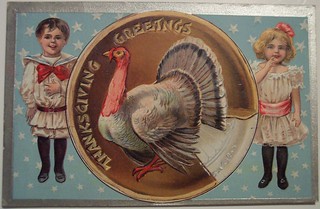There's a famous passage from a 17th-century collection of recollections by Pilgrim leaders William Bradford and Edward Winslow that's often quoted in reference to Thanksgiving:
That night we returned again a-shipboard, with resolution the next morning to settle on some of those places; so in the morning, after we had called on God for direction, we came to this resolution: to go presently ashore again, and to take a better view of two places, which we thought most fitting for us, for we could not now take time for further search or consideration, our victuals being much spent, especially our beere, and it being now the 19th of December [1619].[emphasis mine]
That debunks a late November landing, in time for what we now call 'Thanksgiving.' And, that part about the Pilgrims landing at Plymouth Rock because they had run out of beer? Not so fast, says beer historian Bob Skilnik. 1 That's not exactly what transpired.
Land was sighted on November 9 [1619] but [the Pilgrims] didn't attempt to set out a landing party until days later, when they also realized they were no where near the Virginia Colony but instead were off Cape Cod. By December 4, they knew they had to quit being picky about where they were and settle down. Cold weather and disease were starting to take their toll. After an armed run in with some more Indians, the Mayflower headed south and another expedition found "running brooks," cornfields, and after sounding the depth of the harbor, realized this was about as good as it could get in the middle of December and the dead of winter. Despite what looked like prime territory, they took yet another look around, finally resolving that it was time to make a decision, pick a spot and start a settlement.
That was some seriously unfortunate dithering by the Pilgrims.
So what we have here, my friends, is NOT a party of starving Pilgrims who simply pulled up to Plymouth Rock because they were out of beer, had no water and no "victuals" on hand. No, what has been described instead was a group of naive individuals who called a little bit too much on God for direction, failed to heed the philosophy that "God helps those who help themselves," took too long to pick a spot to settle down, even if it was to only to be for the winter, and as a result of indecision, watched as more than half of them died through the winter.
The ship's crew —hired hands— had, however, planned ahead. They stored a stash a beer, not for their landed passengers, but for themselves to consume on their own return trip to England after the winter storms had abated. Water was not always a healthy drink in the 17th century; sanitation was far from pristine. Beer could be a potable substitute. On shipboard, however, that beer was not low-alcohol or 'small' beer, according to Skilnik. It was 'Ship's Beer', "brewed to a high alcoholic content in order to keep it viable during a prolonged sea passage."
Despite this, the Pilgrims would survive. Two years later, in 1621, the Pilgrims first observed a Thanksgiving, if not calling it that, celebrating the colony's first successful harvest with the Wampanoag, a confederation of local Native American tribes. That the Pilgrims, passionate Christians, prized their supply of beer as an essential foodstuff stands in contrast to some less-tolerant latter-day views.
In the ensuing decades, several local governments proclaimed days of thanksgiving. The Wampanoag fared poorly, inflicted with disease, warfare, and slavery.
Over a century later, in 1789, President George Washington first declared a national day of Thanksgiving. During the Civil War, Sarah Josepha Buell Hale —a supporter of women's rights, a co-founder of Vassar College, and the author of Mary Had A Little Lamb— convinced President Abraham Lincoln to declare the fourth Thursday of November 1863 as national Thanksgiving. In 1941, President Franklin Roosevelt signed a bill legally standardizing the fourth Thursday of November as a federal holiday. 2
Be safe in your travels this Thanksgiving ... and, once you get there, stay put, give thanks, and enjoy your beer(e).
-----more-----
- 1 Bob Skilnik is the the author of a history of American beer and food (now unfortunately out-of-print: Beer & Food: An American History.
- Skilnik's website is still up, but is not fully functional. It no longer links to his full essay on the Pilgrims and Thanksgiving. (I wrote an earlier version of this post, in 2007, when his website was still active.)
- The late William Brand of the Oakland Tribune wrote a good synopsis of Skilniks' research. Here, from 2007.
- 2 My references for the history of Thanksgiving is from Wikipedia. Not rigorous, I know, but sources are given for the data.
- The painting at the top of the page, "The First Thanksgiving," is by Jennie Augusta Brownscombe (1850–1936), "an American painter, designer, etcher, commercial artist and illustrator. Brownscombe studied art for years in the United States and in Paris. She was a founding member, student and teacher at the Art Students League of New York. She made genre paintings, including revolutionary and colonial American history." Wikipedia (again!).
- "To give thanks is a matter of joy. Should that be confined by excessive sobriety?" How Michael Jackson, the British beer writer, saw American Thanksgiving: here.











No comments:
Post a Comment
Comment here ...